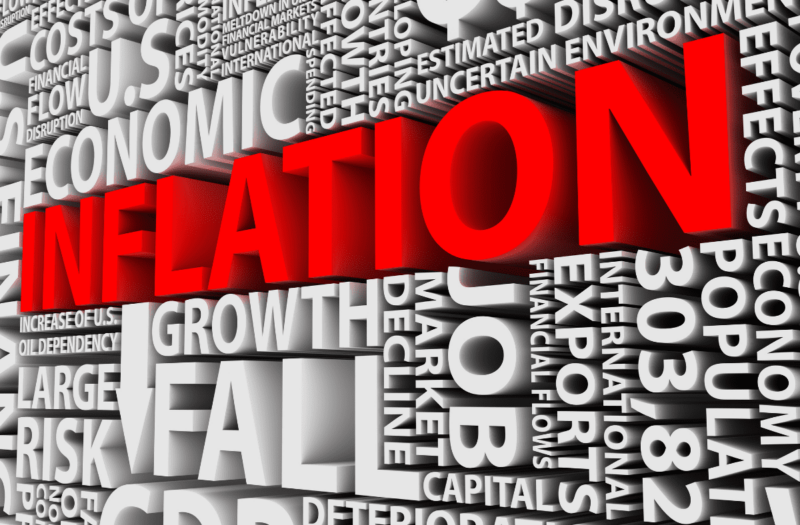

As inflation continues to heat up—a new report from Goldman Sachs cautioned that rates may not cool off this year as many had hoped. “The inflation picture has worsened this winter as we expected, and how much it will improve later this year is now in question,” Goldman Sachs economists wrote.
A measure of inflation that the Federal Reserve watches closely accelerated again in February, hitting a new 40-year high and speeding up on a monthly basis as food and energy prices climbed sharply. Now, nearly nine in 10 adults say they are at least somewhat concerned about inflation, according to a survey conducted recently by the online research firm Momentive for The New York Times.
With the fear of inflation weighing on people’s view of their finances and the economy overall, only 14 percent of employed respondents in the survey said they had received a raise significant enough to keep up with inflation.
At the same time, Goldman Sachs noted the widest gap between available jobs and workers in postwar US history. “The one-two punch of high inflation expectations and a strong jobs market threaten to ignite a moderate wage-price spiral,” Goldman Sachs said, somewhat reversing its previous assessment that there is little risk of such a spiral.
While companies scramble to deal with increasing commodity prices, supply constraints and higher wages caused by labor shortages, a recent report by Harvard Business Review says that cutting expenses is a vital part of how companies can weather the storm.
With labor shortages and ballooning labor costs, Harvard Business Review shares that shifting how work is done can have the greatest impact on the bottom line. “Companies that do this well use a clean-sheet mindset, which can help reset the way work is done. This approach forces companies to scrutinize both what activities are performed and how those activities are performed.”
As inflation looms, companies across industries are reexamining their work and determining what adds the most value, providing both cost savings and the opportunity to deploy dollars and scarce labor resources to what will help them grow, they noted.
HBR reported that as companies prepare for higher inflation in this new environment, they will need to make moves that not only cut costs but also build more scalable growth—positioning them to strategically reinvest in programs that deliver greater resilience. “By playing both offense and defense in a disruptive environment, they position themselves to outpace less-proactive competitors long after the volatility ends.”
At the start of 2022, 64% of the U.S. population was living paycheck to paycheck, up from 61% in December and just shy of the high of 65% in 2020, according to a Lending Club report.
Additional research conducted by The Conference Board reported that nearly a third of people who resigned from their jobs during the pandemic are getting paid at least 30% more in their new positions. However, with compensation weighing heavy on workers’ minds—62% say they are concerned their paychecks won’t keep pace with higher inflation.
A tipping point that is pushing more people into the gig economy. But it’s not because of money alone.
Although the survey included insights on remote work—there were several findings with implications for retail and grocery employers. In addition to outlining the trend of job shifts for higher compensation, The Conference Board found that flexibility is a growing priority for people in the labor market. Flexibility was identified by 71% of respondents as a top priority, driven by keen interest among Millennials and Gen X employees.
“The higher cost of living is spurring many individuals to supplement their incomes and use platforms to do so,” reported PYMNTS. “Flexibility is key in getting us to join the platform economy, to embrace gig work and to match new supply to demand—and inflation is what may keep us there.”
| Cookie | Duration | Description |
|---|---|---|
| cookielawinfo-checkbox-analytics | 11 months | This cookie is set by GDPR Cookie Consent plugin. The cookie is used to store the user consent for the cookies in the category "Analytics". |
| cookielawinfo-checkbox-functional | 11 months | The cookie is set by GDPR cookie consent to record the user consent for the cookies in the category "Functional". |
| cookielawinfo-checkbox-necessary | 11 months | This cookie is set by GDPR Cookie Consent plugin. The cookies is used to store the user consent for the cookies in the category "Necessary". |
| cookielawinfo-checkbox-others | 11 months | This cookie is set by GDPR Cookie Consent plugin. The cookie is used to store the user consent for the cookies in the category "Other. |
| cookielawinfo-checkbox-performance | 11 months | This cookie is set by GDPR Cookie Consent plugin. The cookie is used to store the user consent for the cookies in the category "Performance". |
| viewed_cookie_policy | 11 months | The cookie is set by the GDPR Cookie Consent plugin and is used to store whether or not user has consented to the use of cookies. It does not store any personal data. |

Breathing life into an idea and making it a reality, Jen has spent countless hours building the Hyer platform with three goals in mind: giving people a sense of purpose by providing them with meaningful work opportunities; helping businesses solve workforce problems; and giving back to the communities we serve.
Her passion for helping solve business challenges has fueled Jen for more than two decades. Prior to co-founding Hyer, she worked at PepsiCo—where she was responsible for overseeing the Sales and Go-to-Market IT systems for Pepsi North America Beverage—which spanned 35,000 users across US and Canada. In her role, Jen worked with Dave and Pankaj to spearhead the Sales Transformation initiative, which drove significant top and bottom line benefits for the company.
Jen holds a B.S. in Business Administration and a Master’s Degree in MIS from the State University of New York at Albany.
Going on Who Wants to be a Millionaire? If 80’s & 90’s music and hairbands come up—use your phone a friend on Jen—she’ll have your back.

A people person by nature, Mike’s reputation for building meaningful relationships is second to none. Working to support business partners, his unwavering passion for helping customers find success at every stage is evident in the work he does.
Backed with nearly four decades of experience, Mike led the execution of retail sales priorities at Pepsi Co where he was responsible for growing 1.2B in annual revenue across the Central South Region. His dedication to customers along with his team earned him the recognition of Best of Pepsi in 2010.
Mike holds a Bachelor’s Degree in Business Administration from Eastern Michigan University.
While Mike might tell you he loves to play poker—what he won’t tell you is he has a terrible poker face.

Katie leads the marketing organization at Hyer with the honest belief that success comes through the success of others. In her role she oversees communications, marketing strategy and management across all channels. Katie brings with her a wealth of expertise from both in-house and agency experiences.
Prior to joining Hyer, Katie spent 20 years developing and executing marketing strategies for some of the nation’s largest brands. From major players like Microsoft—to leading tech start-ups—her work has earned her multiple American Advertising Awards, recognizing her for her creative and strategic spirit.
A storyteller by nature, make sure to carve out some time if you ask her about her love for fishing and hunting—just don’t tease her about her Minnesota accent.
Katie holds a B.A. in Marketing and Mass Communication from North Dakota State University. Go BISON!

Dan’s passion for helping partners succeed sparks from his upbringing in a three-generation small town grocer his family operated in New Jersey. While so much has changed by way of technical advancements, his belief is that people that still matter most, every time. With this overhead vision, Dan leads Hyer’s partnership strategy with the mission to build relationships in pursuit of a better way to work.
Prior to joining Hyer, Dan spent more than 15 years in the retail/eCommerce/gig space in partner-facing roles at Anheuser-Busch, Amazon and most recently Shipt where he served as VP of Business Development. In that role, Dan led all new partnership acquisition and revenue across Retail and CPG Industries and was responsible for expanding Shipt’s footprint through national and local partnerships.
If you can kick-start a conversation before Dan beats you to it—hit him up for his experience as a childhood textbook model. It’s worth a laugh.
A proud St. Joseph’s University Hawk, Dan holds a Master’s Degree in Food Marketing.

An experienced, accomplished and passionate leader, Mario is a quintessential “people person” that loves relationship building and dynamic problem-solving—which allows him to learn something new every day.
Bringing more than 35 years of executive experience to the Hyer team, Mario retired in 2018 as the Senior Vice President and General Manager of the Franchise Business Unit of PepsiCo North America. With an impressive track record of leading large and complex businesses to exceed profit targets, revenue growth, market share and organizational goals—he instilled a spirit of partnership among both company-owned and independent bottlers. That spirit of partnership still exists in the work he does today.
He holds a BS Degree in Business Administration from the State University of New York at Oswego.
Mario and his wife, Susan, reside in Brewster, New York—but flock to Palm Beach, Florida during the winter months so he can work on his golf game.

Standing at the forefront of expertise and innovation, Hyer Founder and CEO, Dave Dempsey knows a thing or two about fulfilling work. Backed by nearly four decades of executive experience—Dave launched Hyer in 2019 in an effort to change the way work gets done—while empowering people along the way.
Prior to starting Hyer, Dave spent 37 years at PepsiCo, building a strong reputation throughout many strategic and executive roles—most recently serving as the Vice President of Sales Transformation. Over his tenure at PepsiCo, Dave was the proud recipient of multiple awards—recognizing him for his proven results, outstanding ethics and overall drive for success.
While Dave is thrilled to have received Pepsi’s most prestigious honor, the Chairman’s Award, the most notable honors that top his personal list include his family, friends and faith. Dave is also a highly respected and competitive cornhole player, currently retaining the title for reigning champion at family events.
Dave holds a BA in Marketing from the University of Hartford in Connecticut.

Pankaj is not your average CTO. He has the ability to think creatively and analytically at the same time—making him our go to guy for nearly any problem. With deep knowledge of technology and infrastructure—coupled with strategy—Pankaj is able to think outside the box and give form and shape to ideas that continually drive results. From legal and financial to market research and branding—his expertise and dedication has helped position Hyer for growth time and time again.
Bringing more than two decades of experience to the Hyer team, Pankaj led Pepsi Beverages Mobility Strategy—which was part of a $100 million dollar sales transformation program designed to support their 30,000+ strong sales force. Driving the development, deployment and oversight of 19 sales and GTM mobile apps—his work enabled the sales team to achieve stellar results.
Pankaj holds a Bachelor’s Degree in Computer Science and Engineering from the prominent Indian Institute of Technology.
If bass guitar strikes a chord with you, his band Raagatonic might be up your alley!

Dan knows a thing or two about solving operational headaches—and works tirelessly to ensure things run not just smoothly—but efficiently. Continuously helping customers improve the way they go about their business; Dan also leads efforts to attract and retain Taskers in meaningful ways.
Passionate about providing a new way for people to make a living outside of the normal corporate structure, Dan was Hyer’s first (and #1 Tasker)—which gave him a deep appreciation for the 50,000+ Taskers who have since followed.
Before joining Hyer, Dan worked for PepsiCo where he managed sales efforts that drove 12 million in gross revenue. Dan received B.A. in Business with a focus in marketing from John Carroll University—go Blue Streaks!
If you’re looking to start a garden—Dan’s the man you want to ask for advice. Just don’t hit him up on beach volleyball night.

When it comes to digging in and making sense of numbers, Joey is our go-to guy. Managing the day-to-day accounting and finance functions at Hyer—he lends a hand to ensure overall operations are running smoothly (and on budget).
Working alongside family—Joey jumped at the chance to join the Hyer team early on as he firmly believes the Hyer App has tremendous potential to positively impact the way work gets done.
Prior to joining Hyer in 2019, Joey spent several years working in due diligence and has extensive knowledge in financial analysis and revenue trends. He holds a BBA in Accounting from Loyola University in Chicago.
While Joey loves to talk numbers—if you really want to kickstart a conversation—just ask him about his can koozie collection.